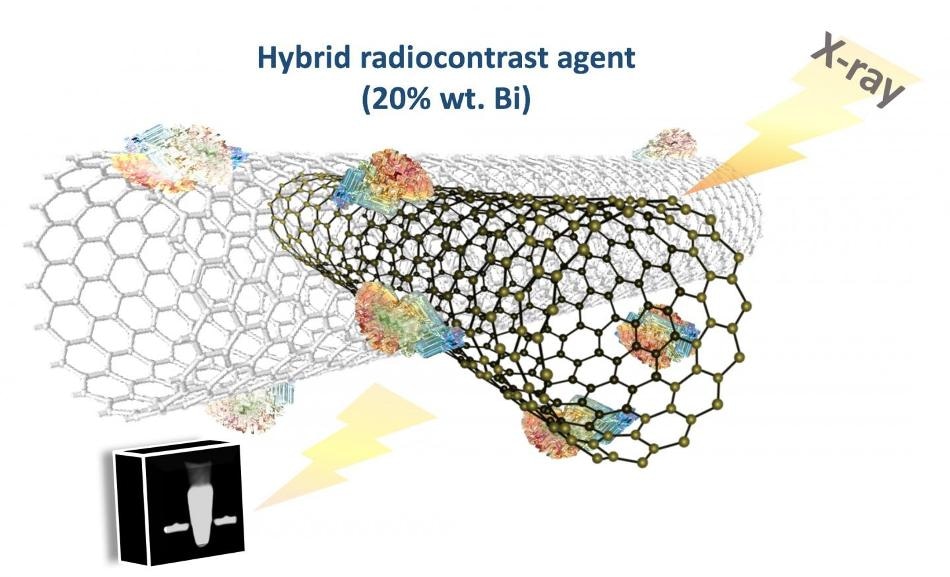Feb 1 2017
 An improved compound of bismuth and carbon nanotubes called Bi4C@US-tubes, developed at Rice University, CHI St. Luke's Health-Baylor St. Luke's Medical Center and Baylor College of Medicine, could enhance the ability to track stem cells as they move through the body and target diseases. Click on the image for a larger version. (Courtesy of the Wilson Research Group)
An improved compound of bismuth and carbon nanotubes called Bi4C@US-tubes, developed at Rice University, CHI St. Luke's Health-Baylor St. Luke's Medical Center and Baylor College of Medicine, could enhance the ability to track stem cells as they move through the body and target diseases. Click on the image for a larger version. (Courtesy of the Wilson Research Group)
Researchers at Rice University have synthesized a new and significantly enhanced generation of contrast agents for tagging and real-time tracking of the body’s stem cells.
The agent integrates ultrashort carbon nanotubes and bismuth clusters that can be seen in X-rays captured using computed tomography (CT) scanners. According to the researchers, the stable compound performs over eight times better than the first-generation material launched in 2013.
“The primary application will be to track them in stem-cell therapies to see if the cells are attracted to the site of disease — for example, cancer — and in what concentration,” said Rice chemist Lon Wilson of the compound the researchers call Bi4C@US-tubes.
Magnetic resonance imaging is currently used for that purpose and it works quite well, but X-ray technology in the clinic is much more available. It’s faster and cheaper, and it could facilitate preclinical studies to track stem cells in vivo.
Lon Wilson, Chemist, Rice University
The process formulated by Wilson’s team and colleagues at CHI St. Luke’s Health-Baylor St. Luke’s Medical Center and Baylor College of Medicine is reported in this month’s issue of the American Chemical Society journal ACS Applied Materials and Interfaces.
Bismuth is used in pigments, cosmetics, and pharmaceuticals, notably as the active ingredient in an antacid called pink bismuth (aka Pepto-Bismol). For this application, bismuth nanoclusters prepared by the lab of Rice chemist Kenton Whitmire, a co-author of the paper, are integrated with carbon nanotubes chemically treated to reduce them to between 20 and 80 nm and include defects to their side walls.
The nanoclusters, which make up roughly 20 % of the compound, seem to robustly attach to the nanotubes through these defects.
When added into stem cells, the treated nanotubes are easy to spot,
It’s very interesting to see a cell culture that is opaque to X-rays. They’re not as dark as bone (which X-rays cannot penetrate), but they’re really dark when they’re loaded with these agents.
Lon Wilson, Chemist, Rice University
The compound was analyzed using a CT scanner at St. Luke’s Baylor Hospital, which compared the capabilities of empty nanotubes, the former generation of Bi@US-tubes and the new compound. X-ray attenuation of contrast agents are calculated using Hounsfield units.
The tests found approximately 188 Hounsfield units for plain ultrashort nanotubes, 227 for older Bi@US-tubes, and 2,178 for the most recent compound. Most soft tissues belong between 30 and 100 Hounsfield units, so cells labeled with the new compound were anticipated to stand out.
Additional testing revealed that the clusters held tight to their nanotubes. The researchers did not detect any release of bismuth from the nanotubes analyzed at body temperature beyond 48 hours.
It is now left to the federal Food and Drug Administration to approve the new compound for human use, says Wilson.
But we’re in a position to start preclinical studies now that we’ve determined how well we can load cells and the fact that cells are not seemingly harmed by the technology and short bursts of X-rays.
Lon Wilson, Chemist, Rice University
Rice graduate student Mayra Hernández-Rivera is the paper’s lead author. Co-authors are former Rice postdoctoral researcher Ish Kumar, postdoctoral researcher Sakineh Moghaddam and alumnus Stephen Y. Cho; Benjamin Cheong, a cardiologist at CHI St. Luke’s Health-Baylor St. Luke’s Medical Center, and Merlyn Pulikkathara, a research associate at Rice and Baylor College of Medicine.
The research was supported by The Welch Foundation.